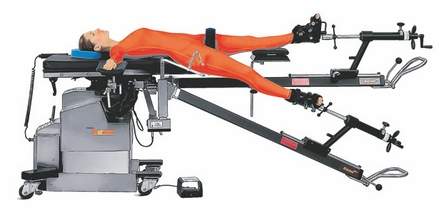Tags
American Academy of Orthopaedic Surgeons, Anatomical terms of location, Health, hip, Hip Replacement, Orthopedic surgery, surgery, UNited States
Revised Hip-Replacement Approach Sparks Discussion Among Patients, Orthopedic Surgeons
Published: Saturday, July 23, 2011 at 12:01 a.m.
Last Modified: Tuesday, July 19, 2011 at 12:49 p.m.
 PHOTO PROVIDED BY MIZUHO OSI
PHOTO PROVIDED BY MIZUHO OSI
The hana orthopedic surgery table, manufactured by Mizuho OSI in Union City, Calif., is designed to make it easier for orthopedic surgeons to use a frontal approach to the hip joint during hip replacement surgeries.
LAKELAND | Whether to enter the hip from the front, instead of the more traditional rear and side approaches, is becoming a hotly debated topic among orthopedic surgeons who do total hip replacements.
Dr. Todd Hall, an orthopedic surgeon at Lakeland Regional Orthopedic Associates, is among those who strongly support the non-traditional approach. He returned to doing non-emergency total hip replacements during the past year when Lakeland Regional Medical Center purchased a specially designed table allowing the anterior (front) approach to be done more easily than it could on a standard operating table.
“It’s something new to us at this institution and something we would like to make more use of,” said Hall, who does much of his surgical work with trauma care and post-traumatic reconstruction.
“I definitely would like to make it the standard approach. It’s a true muscle-sparing approach.”
Total hip replacement is the surgical replacement of the ball and socket of the hip joint with artificial parts.
Doing it from the front lets orthopedic surgeons work between the muscles instead of detaching muscles, according to the American Academy of Orthopaedic Surgeons.
The AAOS also said patients can bend their hips and bear full weight more quickly after anterior-approach surgery.
Another advantage is that, doing the anterior approach, he can use a specialized X-ray technique allowing him to see images in real time, Hall said.
Many surgeons in Gainesville and Ocala like the anterior approach, according to a recent article in the Gainesville Sun.
Not all orthopedic surgeons are using it, however, there or in Polk County.
Dr. Phuc Vo, a Watson Clinic orthopedic surgeon in Lakeland, is more cautious.
“It’s another option, not revolutionary and new,” he said. “We used it for various reasons in the past.”
Difficulty in doing anterior hip replacements, along with added time, may be one reason they didn’t become the standard in the United States. The new style of surgical table makes this approach easier to do than before.
Vo said 75 percent to 80 percent of total hip replacements are done with the posterior approach.
“Anything new does not have the studies to prove it is better than the ‘traditional’ way of doing things,” he said.
What’s lacking in this debate are long-term results from gold standard, double-blind, randomized trials. These would put hip-replacement patients randomly put into groups for specific approaches — front, rear or side.
“We need to know how they do over the next 20 years,” Vo said.
Vo said he doesn’t see conclusive proof it speeds up recovery or reduces the risk of post-surgery hip dislocations.
A third orthopedic surgeon, Dr. Marc Volpe of Watson Clinic, takes a middle ground.
The anterior approach is more difficult and has a little higher risk of complications during surgery, such as fracturing the thigh bone, said Volpe, who does some hip replacements that way.
On the plus side, it allows fewer restrictions on hip-replacement patients as they heal from surgery, Volpe said.
A year from surgery, he said, there’s no indication the patient will be any better off.
His conclusion: “It will help expedite the recovery but it’s no miracle.”
Hall and other supporters predict the use of the anterior approach will spread with increased familiarity.
“More and more surgeons are understanding (its) advantages and explaining them to their patients,” Hall said.
[ Robin Williams Adams can be reached at or 863-802-7558. Read her blog at robinsrx.blogs.theledger.com. ]
Related articles
- Techniques In Implementing A Hip Replacement Operation (earlsview.com)
- Biomet Receives FDA Clearance for Active Articulation(TM) E1(R) Dual Mobility Hip System (earlsview.com)
- New Stryker Hip Replacement System looks Good (earlsview.com)

Pingback: Computer-Assisted Hip Replacement Surgery – A More Accurate Placement of the Implant Ensures Better Outcomes for the Patient « Earl's View
Pingback: Innovative Anterior Hip Replacement Surgery « Earl's View
Pingback: SPecial Surgery Table for Anterior Hip Replacement Operations … | www.drfouly.org
Pingback: Smaller scars, faster recovery for new hip replacement « Earl's View
Pingback: Hip Dislocations – Why? « Earl's View
Pingback: Anterior Hip Replacements are the Future « Earl's View
Pingback: Hip replacement surgery in India « Earl's View
Pingback: Less Pain – Faster Recovery « Earl's View
Pingback: Revision Hip Replacement (RHR) « Earl's View
Pingback: 300 Montana veterans wait for orthopedic surgery as VA tries to recruit surgeon « Earl's View
Pingback: How to Prevent Hip Dislocation After a Total Hip Replacement « Earl's View
Pingback: Anterior Hip Replacement « Earl's View
Pingback: Anterior Approach Hip Replacement at Saint John’s Health Center Helps Tom Watson Play Historic British Open « Earl's View
Pingback: Doctor Kickbacks – Who Does Your Doctor Really Work For? « Earl's View
Pingback: Orthopedists liable under federal anti-kickback statute « Earl's View
Pingback: Hip Repalcement – Anterior Approach Gives Patients Another Option « Earl's View